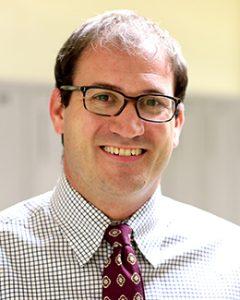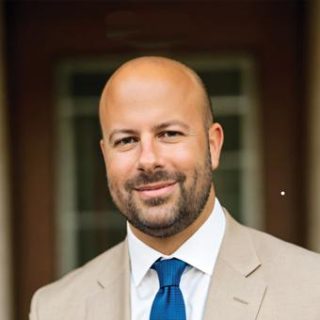FOCUS
Principals: To maximize impact, focus on your school’s priorities. ONLINE EXCLUSIVE
By Ted Domers
Categories: Change management, Evaluation & impact, LeadershipAugust 2023
Early in my tenure as a principal, I had coffee with a veteran school leader and mentor. As we discussed the complexities of leadership, he asked, “What is your biggest challenge?” Before I could answer, he added, “And you can’t say time.” This comment has remained with me for a decade, as I work to improve my leadership on behalf of the children in the Philadelphia area. Educational leaders would love nothing more than to have more time. However, it’s difficult to come up with more of this essential resource. Over the years, I have come to realize what matters is not how much time we have, but how we use it.
I served the School District of Philadelphia for eight years as a principal and two years as an assistant superintendent. In my assistant superintendent role, now in a nearby district, I develop common practices for school improvement, including various layers of support from network-wide professional development to grouping schools based on common problems of practice to individual coaching. In doing so, I recognize principals as the single most important driver for school growth (Grissom et al., 2021). Supporting the principals across my network in our work of improving the educational experience for students is a critical responsibility.
The challenge of finding time is ever-present for all of us — me, the principals, and the staff they lead and support. But when leaders try to find more time, we are seeking a technical solution, when what we really need is an adaptive one (Heifetz & Linsky, 2017). An adaptive approach requires leaders to take a learner’s stance, reimagining a challenge through new framework, rather than applying previous solutions to a new problem. As our work continues to evolve, we must support principals through an adaptive approach to lead their schools with the unique needs of their school at the center. When leaders shift their focus to how time is used, they can more effectively shape their context and deepen their influence. To accomplish this shift, school leaders must focus on centering their priorities, investing in designing systems, and focusing on impact. A recent effort to leverage professional learning communities (PLCs) demonstrates how.
Administrators must evolve and support principals with an adaptive approach. We need to ask ourselves, how is time used? Are the unique needs of the school at the center of the work? @teddomers #Principals #EdAdmin #PLCs Share on XCentering priorities
In coaching principals, this refrain often rings true: “If you are doing everything, you are doing nothing.” Too often, quantity is valued at the expense of quality, and principals are sometimes rewarded for attempting to take on every challenge. But their school systems are not better for it.
The pandemic provided an opportunity to remember the importance of honing our focus. During virtual learning in the 2020-21 school year, our district knew we needed to be strategic about professional learning, so we decided to reinvigorate our commitment to PLCs, with a central tenet to maintain a focus on learning. I worked with principals on leading effective PLCs, emphasizing teacher development as a means to increase student learning (Dufour et al., 2016). If principals were going to move our schools forward during that challenging time, they needed to prioritize communication and engage teachers in meaningful, shared learning experiences.
The road to a smooth process was a bumpy one. For example, upon identifying a problem in her school’s PLC implementation, a principal I worked with knew the time was not well spent. Frustrated at the lack of growth in teacher practice and limited PLC participation, we reflected on the root cause together. She determined that a distributed leadership model would build engagement in classroom visits and PLC design. To do this, she sought out teacher leaders to help reframe the need for schoolwide instructional growth. Several of these teacher leaders conducted classroom visits and compiled schoolwide trends that were not connected to individual teachers. Using the data, they targeted high-leverage learning strategies to address an overreliance on technology in the classroom and create more authentic learning, shifting the emphasis in their PLCs and increasing participant engagement. Through recognizing the importance of time efficiency and by including teacher leaders, she made better use of time and positively impacted teacher practice.
Another principal shared his dilemma about how to organize his PLCs in the 2023-24 school year. He understood the potential for both departmental PLCs and grade group PLCs to support student learning. When he said, “We just don’t have time for both,” I knew I needed to organize my questioning to help him understand his priorities, probing to better unpack the leverage points in the school and which structure would lead to the biggest impact. In my mind, either approach would support his school, but my role was to help him elevate the area for greatest impact. After discussion, he ultimately chose PLCs by grade configuration, and, along with his leadership team, devised and aligned a plan.
In both cases, we focused our conversations to reveal what was most important and prioritize how we spent PLC time. Through framing our focus areas, time does not present the same obstacles because it offers a different vantage point on the school organization. Our leadership stance must consider how we can build capacity in addressing the greatest need in our schools. This comes down to strategically centering priorities.
Designing systems strategically
Leaders play an important role in establishing strategic focus for teams’ time together. Simply sitting in a room together to work on disconnected tasks does not lead to positive outcomes. Rather, as Andy Hargreaves describes, it often results in “contrived collaboration.” When this occurs, teachers grow to resent the time for teacher meetings (Hargreaves, 2010). To counter this, principals must plan impactful learning opportunities for and alongside teachers and strategize methods to ensure the learning is relevant and meaningful. And they should be an active part of the process. Too often, principals see their role as setting time aside for teachers and staff to work together and stepping back. While distributed leadership is critical, and principals should not micromanage teacher learning, principals play an essential role in the PLC process.
At the start of the PLC initiative, principals identified a variety of learning experiences for teachers, and some principals focused the PLC meetings on multiple topics in a rotation. For example, in a typical four-week month, they might rotate the meetings’ focus between co-planning, student support, reviewing student work, and equity. While developed with the best of intentions, this approach had two unintended and negative consequences.
First, teachers were overwhelmed with the pace of the initiatives. With a finite timeline, initiatives could not take root and meetings seldom went beneath surface-level understanding. Second, principals were overwhelmed with the scope of planning required for these meetings. Principals regularly identified the challenges their teams faced in keeping up with week-to-week planning. In response, I would often hear, “There isn’t enough time.” Taken together, it was clear that the PLC design was flawed. Again, the issue wasn’t the time, it was that we were not using it in an effective manner. We were trying to do too much, too quickly.
To shift our design, I worked with principals to hone strategy and focus on impact and sustainability. In one school, a thoughtful and innovative leader coined the term “burst cycles” to build momentum in her PLCs. She planned three- to five-week cycles, each with a singular focus ranging from student work analysis to student supports to schoolwide initiatives. Her planning focused on the immediate needs of the teachers to create timely opportunities for professional learning.
At the start of an academic quarter, for example, teachers unpacked standards to refine their units of study, commit to learning outcomes, and develop plans to share student work. By using this protocol, she front-loaded the PLC cycle with a clear timeline and clarified student learning, all while directing teachers toward an achievable end goal. These clear expectations allowed each team of teachers to flexibly determine how to best accomplish their work. Based on this structure, the teachers responded with high engagement and evidence of improvements for individual students, classroom practices, and schoolwide programming. This design used the same quantity of time, yet through careful focus and strategic leadership, it opened meaningful learning opportunities for teachers.
PLCs enable leaders to attend to and elevate key initiatives for shared learning. Setting this priority is the first step for successful implementation. Nonetheless, a shift in how we conceptualize our time must go deeper than identifying the need for more minutes. Effective leaders understand the importance of design and planning to promote productive use of this resource.
Focusing on impact
An inherent challenge for school leaders is the vast scope of needs in a school. With a host of responsibilities from instruction to wellness, and from operations to partnerships, the work of a principal is to negotiate a complex web of organizational demands. When distilling key priorities and designing responsive systems, principals must keep the impact on student experience at the forefront. Given the range of demands, principals are often pulled away from initiatives that positively affect students. In turn, the response to this struggle is to characterize lack of time as the underlying issue. However, our use of time shifts when we maintain a singular focus on our students. When principals, with their leadership teams, refocus on student impact, a reactive concern about time is shifted to a proactive consideration of our young learners.
To best center students in her school’s PLC, one principal created short student surveys as the foundation for teacher learning. Along with her team of teacher leaders, they identified practices to support teacher growth and used student feedback as the data for growth. For example, they identified student collaboration as a need in the school and offered a brief, student-friendly survey to garner input for teachers. Building on what students identified as best practices for their learning, teachers then worked over a few weeks to implement those practices, collect evidence of student work, and reflect on how to continue to support the students. With student perception at the heart of teacher learning, this cycle created and sustained a more connected and responsive approach.
The work of being responsive to students is not as easy as it might sound. Reflection and adaptation are key. One principal shared a challenge from his PLCs. “We spend too much time on the student support tracker,” he said, noting that this tool included students at all levels of support. Teachers reported becoming overwhelmed by the detail of parsing out students’ complex needs with such broad data-gathering. In response, we created a new tracker connecting student performance to teacher interventions. With a simplified and actionable student support tracker, the teachers’ time in PLC meetings became more productive. In moving our conversation to the impacts on particular students and a willingness to redesign a tool, we created a more useful resource for our teachers to better support students.
Shift mindset
School leaders must avoid the trap of allowing time to limit their influence. A persistent challenge for principals is unpacking the complexity of their schools, and, too often, this monopolizes our time, isolating our goals. Instead, principals must conceptualize time to create systems focused on their school priorities. To maximize impact for our students, principals must actively and strategically work with the time they have to create transformative learning opportunities for all of our students.
As you consider the biggest challenges in your school system — no, you can’t say time — I would encourage you to shift your mindset and instead look at centering priorities, designing systems strategically, and allowing the pursuit of positive student outcomes guide your improvement work.
As you consider challenges in your school system — no, you can’t say time — shift your mindset to center priorities, design systems strategically, and pursue positive student outcomes to guide your improvement work. #EdLeadership Share on XReferences
Dufour, R., Dufour, R., Eaker, R., Many, T., & Mattos, M. (2016). Learning by doing: A handbook for professional learning communities at work (3rd ed.). Solution Tree Press.
Grissom, J., Egalite, A., & Lindsay, C. (2021). How principals affect students and schools: A systematic synthesis of two decades of research. The Wallace Foundation.
Hargreaves, A. (2010). Presentism, individualism, and conservatism: The legacy of Dan
Lortie’s Schoolteacher: A Sociological Study. Curriculum Inquiry, 40(1), 143-154.
Heifetz, R. & Linsky, M. (2017). Leadership on the line: Staying alive through the dangers of change (2nd ed.). Harvard Business Review Press.

Ted Domers (tdomers@hatboro-horsham.org) is assistant superintendent of Hatboro-Horsham School District in Montgomery County, Pennsylvania.
Categories: Change management, Evaluation & impact, Leadership
Recent Issues
LEARNING DESIGNS
February 2025
How we learn influences what we learn. This issue shares essential...
BUILDING BRIDGES
December 2024
Students benefit when educators bridge the continuum of professional...
CURRICULUM-BASED PROFESSIONAL LEARNING
October 2024
High-quality curriculum requires skilled educators to put it into...
LEARNING TO PIVOT
August 2024
Sometimes new information and situations call for major change. This issue...












